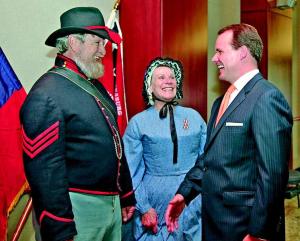By Cathy SpauldingMuskogee Phoenix Staff Writer
A new 5,000 square-foot visitor center could be in place at the Honey Springs battlefield in time for the 150th anniversary of the Civil War battle.

Oklahoma Lt. Gov. Todd Lamb, right, talks with Historical Society volunteers and civil war re-enactors Gerald Krows, left, and Jean Krows, center, following an announcement of plans for a $1.9 million visitor’s center at the site of Oklahoma’s largest Civil War battlefield in northeast Oklahoma, at a news conference in Oklahoma City on Monday. (Photo courtesy of Muskogee Phoenix)
On Monday, the U.S. Department of Agriculture Rural Development announced a $1.9 million public-private partnership that includes the Oklahoma Historical Society, McIntosh County and an area nonprofit organization.
Oklahoma Historical Society Director Bob Blackburn said the USDA will fund $500,000 through a grant and $600,000 through a 40-year, 4 percent loan to be repaid by the Friends of Honey Springs Battlefield. The rest of the funds will come from cash on hand or money to be raised by the Oklahoma Historical Society. Blackburn said the visitor center would be four miles north of Interstate 40 and one mile east of U.S. 69. From U.S. 69, it will be accessible from the Rentiesville or Oktaha exits, he said.
The visitor center could help the area benefit from Civil War-related tourism. The site could attract up to 100,000 visitors a year, Blackburn said. However, Checotah resident Emmy Stidham, newly elected president of the Oklahoma Historical Society board, said officials expect 150,000 visitors and $9 million in tourism revenue.
“This historic site is very critical to the area,” said State Rep. Ed Cannaday. “I am especially proud. Oklahoma gets to be a site of significance in Civil War tourism.”
The Engagement at Honey Springs — July 17, 1863 — was the largest of more than 107 documented hostile encounters in Indian Territory during the Civil War, according to the Oklahoma Historical Society website. At least 150 men died in the battle, which Blackburn said was critical for Union victory because it paved the way for the occupation of Fort Smith, Ark.
Blackburn said the Honey Springs battle is significant in that it “involved African American soldiers, Indian troops, Texas Confederates.”
“We also can link Honey Springs to Fort Gibson,” he said.
Blackburn said the Historical Society had tried several avenues to fund a new visitor center in time for the battle’s 150th anniversary, July 17, 2013.
He said they found a good contact with Ryan McMullen, state director of USDA Rural Development. Blackburn said McMullen had a keen interest in Civil War history and helped secure the USDA funding.
“The partnership recognizes that rural areas should increasingly capitalize on the tourism industry,” McMullen said. “The development of this attraction will create jobs, as well as educate visitors on one of Oklahoma’s most historic sites.”
Blackburn said architects are designing the visitor center “right now,” and ground could be broken by January.
Some Honey Springs re-enactments bring several thousand people to Checotah, said Lloyd Jernigan, executive director of the Checotah Chamber of Commerce. He said he welcomes a new visitor center for the site.
“Now, we have a visitor center in a doublewide trailer,” Jernigan said.
A Civil War re-enactment held late last April drew 3,000 to 3,500 people to Checotah, he said.
“Quite a few visitors stayed in our hotels and ate in our restaurants.”
The Associated Press contributed to this report.
Reach Cathy Spaulding at (918) 684-2928 or [email protected].
Click here for a description of the battle.

